How chickpeas grow in nature and on the site
Chickpeas have only recently appeared on supermarket shelves, but have already won the love of those who have tried dishes made from this legume. Previously, Turkish or lamb peas, as chickpeas are also called, were grown only abroad. Now many farms have allocated significant areas for this valuable crop. Summer residents are also actively mastering the technology of growing chickpeas on their plots.
Read the article about how chickpeas grow in nature and how to grow them in the country.
How chickpeas grow in nature
Lamb peas are an annual leguminous plant with a powerful root system.. It occurs naturally in regions with tropical and subtropical climates. The Middle East is considered its homeland, where it is widespread to this day. As a cultivated plant, chickpeas are grown all over the world, with each year the area under cultivation increases in different countries.
For reference. Currently, wild chickpeas grow only on the Arabian Peninsula and in the Middle Eastern countries.
During the growth period, the plant goes through four phases: from germination through budding and flowering to ripening. The last two are divided into tiers, since chickpeas bloom and ripen gradually, from the bottom of the stem to the top of the stem.
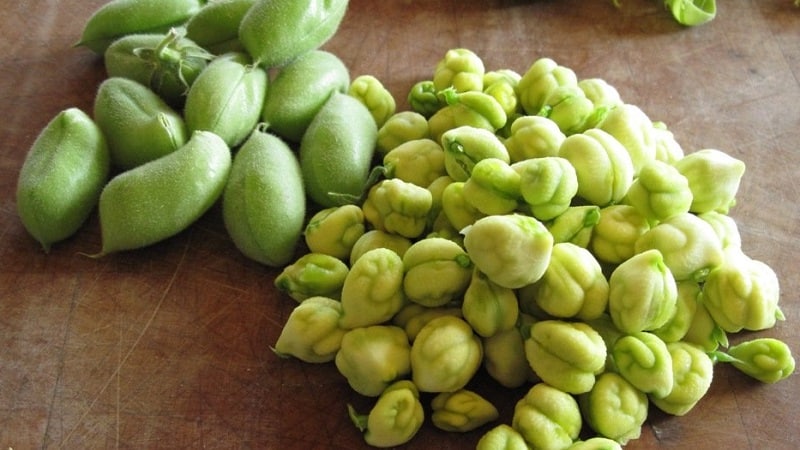
There are four periods from the emergence of seedlings to the beginning of the ripening phase:
- The first lasts 30-45 days and covers the stage from germination to budding. During this period, the plant grows green mass and lays fruits.
- The second one is completed in three weeks. By the end of the period, chickpeas reach their maximum height, finish flowering and begin to form fruits.
- The third lasts 20-25 days and ends with the final formation of fruits, which stop growing by the end of the period. This stage is characterized by maximum foliage.
- The fourth period lasts from 1 to 1.5 months, during which the beans are poured.
Depending on the varieties and weather and climatic conditions, the growing season lasts from two to four months.
Reference. Chickpeas are a source of soluble and dietary fiber. The former remove bad cholesterol from the body, the latter stimulate intestinal activity. The glycemic index of fruits is so low that they are recommended for weight loss and in the diet of diabetics.
How to grow chickpeas in the country, agricultural technology in open ground
It is not difficult to cultivate lamb peas in a home garden.: even in a continental climate, with proper agricultural technology, the plant produces good yields.
In crop rotation, chickpeas will be an excellent predecessor and successor to winter wheat. On agricultural farms they are planted this way – one after another. Few people grow wheat in their summer cottages, but careful selection of neighbors is always helpful - for example, garlic grows well next to lamb peas.
You can’t plant chickpeas after legumes and sunflowers.. It is grown in one place with a break of 4-5 years. Chickpeas tend to increase soil fertility and saturate it with nitrogen, so not only wheat and barley, but also nightshades grow well after this crop.
This is interesting. Ground chickpeas have been used since the 18th century as a coffee substitute.
How to plant chickpeas
The culture is resistant to droughts and low temperatures. Therefore, it is planted in early spring, when the soil is maximally saturated with moisture. Choose a site that is well lit by the sun and not clogged with rhizomatous perennials.
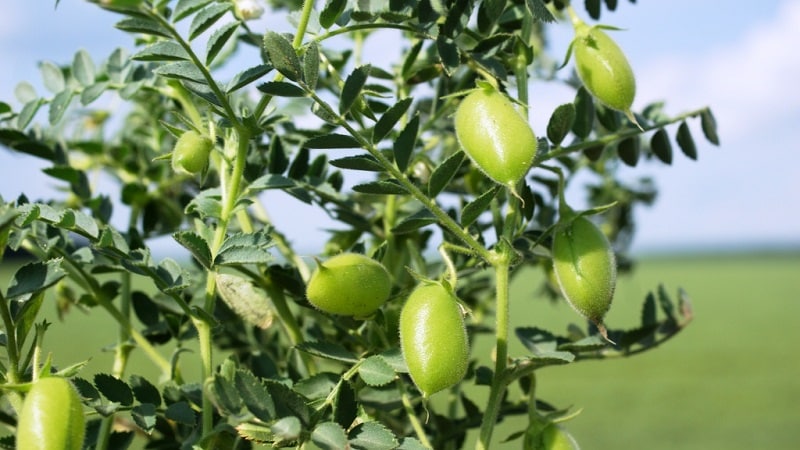
Soil cultivation technology for chickpeas
They prepare the land for the crop in the fall, since with early sowing there is not enough time for spring work. After harvesting the predecessor, the area is plowed to a depth of 30-35 cm. Deep plowing promotes complete aeration and moisture accumulation, which is important for the formation of the root system and nodules of chickpeas. An excellent preventive measure against soil contamination is disking 2-3 times at different angles.
If tillage is carried out manually, carefully select all weeds.
Attention! Harrowing is carried out in the fall, then immediately after the snow melts, crops are sown. If the snow cover was weak or disappeared early, re-harrowing is done before planting chickpeas.
Seed preparation and seeding rate in kg
If the soil is sufficiently moist, the planting material is not soaked. If there is a lack of moisture, allow the seeds to germinate for 2-3 days. Before planting, the fruits are soaked in any preparation of nodule bacteria. This will increase the germination and yield of chickpeas by 25-30%.
Sowing seeds
Seeds are planted at a depth of 6-8 cm in moist soil, and about 15 cm in dry soil.. The furrows are placed at a distance of at least 30 cm from each other to facilitate weeding and loosening during plant growth. After planting, the soil is rolled or lightly tamped so that there are no voids, otherwise the seeds will take a long time to germinate and not be smooth.
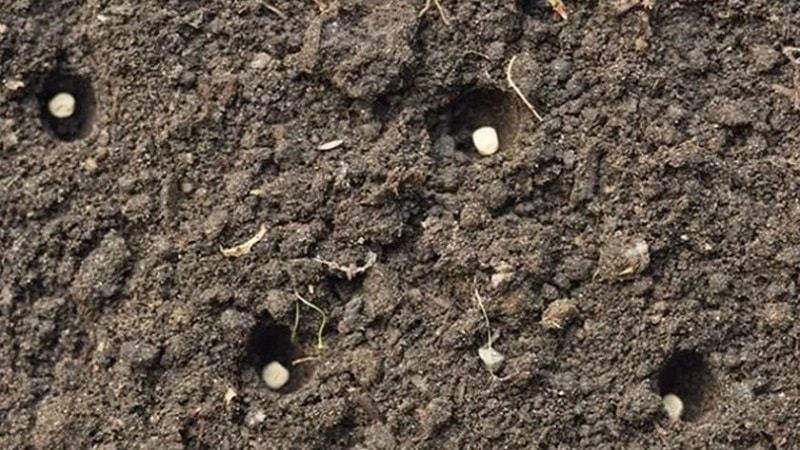
Crop care
When weeds appear, they are pulled out and the row spacing is harrowed to a depth of 5-6 cm. When the rows are closed, there is no need to harrow; the green chickpea leaves shade the soil well and prevent weeds from rising.
Watering is carried out moderately, avoiding waterlogging of the soil. Chickpeas tolerate a lack of moisture well, but get sick if there is too much water. Before the emergence of seedlings, water the plantings once every 3-5 days, and once the sprouts reach 10 cm, no more than once a week.
During the growing season, fertilizing with mineral fertilizers is carried out.. Chickpeas respond best to potassium-phosphorus preparations.
Important! The use of nitrogen fertilizers interferes with the development of nodules and reduces their ability to attract nitrogen from the air.
Weed control
Chickpeas love clean soil, so prepare the planting area in advance, plowing, harrowing and getting rid of weeds, especially rhizomatous perennials.
To combat soil weeds, a continuous action herbicide is used. "Tornado 540" during the period before planting or immediately after sowing. In addition, soil preparations “Simba”, “Lazurit” and “Gambit” performed well.
During the period from germination until plants reach a height of 20-25 cm, row spacing is regularly loosened and weed out any weeds that appear. Then the rows close together and the chickpea’s own foliage prevents weeds from developing.
Interesting things on the site:
Chickpea pests and their control
Lamb peas are sensitive to infections, pests and diseases. The most common diseases are fusarium and ascochyta blight. In the first case, chickpeas are affected by a fungus that settles on plant debris and in the soil. Effective prevention will be the timely destruction of all waste after harvesting, digging and harrowing.
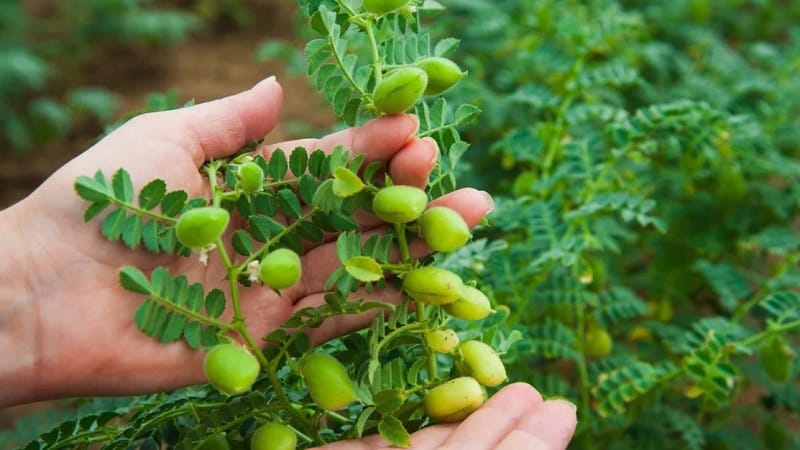
Ascochyta blight leads in some cases to the complete destruction of plantings.. Plants get sick either because of damaged seeds or because of rainy weather.If signs of both diseases are detected, it is necessary to treat the crops with fungicides.
Major pests:
- the nodule weevil eats the green part of the leaves, making them look like thin lace;
- chickpea mutating fly: when infected by this insect, the leaves turn yellow, curl and fall off.
Broad-spectrum insecticidal preparations are used against pests such as “Decis”, “Calypso”, etc.
Harvest
Ripened chickpea pods become stiff and light in color. If you shake it, you hear a characteristic sound - dry peas rolling around inside. Harvesting takes place in several stages, since the chickpeas ripen gradually, starting from the lower tiers.
Chickpea yield per 1 ha
Average figures – from 0.18 to 0.5 tons per hectare. On farms using modern agricultural practices, chickpea yields reach 0.9 t/ha.
Ripening time
The first harvest begins in late July - early August. The harvesting season lasts up to a month. The timing of ripening strongly depends on the chickpea variety (early, middle or late), the timing and depth of sowing, as well as weather and climatic conditions.
How to harvest
The pods are removed from the plants starting from the bottom of the stem. Then they peel and leave the peas to air dry, if necessary. When fully ripe, the fruits are immediately removed for storage.
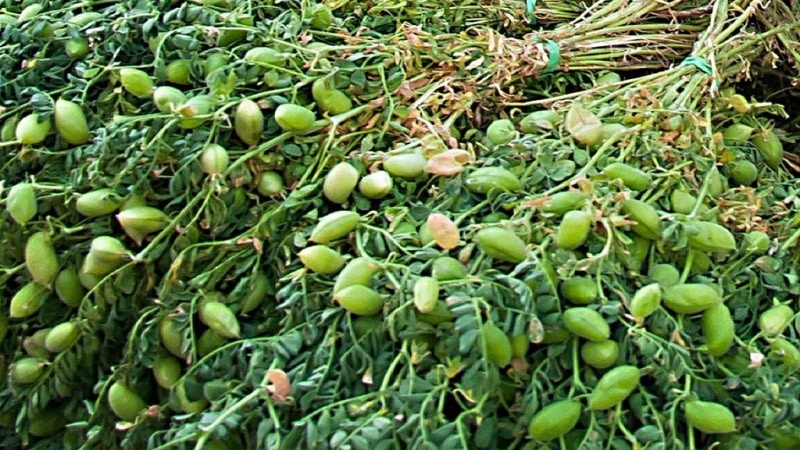
Features of growing chickpeas
For each region, varieties are selected depending on climate, soil, possibility of return frosts and precipitation rates.
In outskirts of Moscow
Central Russia is favorable for growing chickpeas. Here, to the extent of sunny days and precipitation, early and middle varieties have time to ripen before the autumn slush.
Proven to be the best Volzhanin 50, because it is moisture-loving and a rainy spring or summer will not prevent you from getting a good harvest.
In Siberia
For cold regions, early ripening varieties are chosen. Then, even after planting chickpeas in June, the ripened fruits are harvested in August. Privo 1 is considered the earliest: the record holder for early ripening, drought resistance and productivity. The growing season from germination to harvesting is only 45 days.
In Krasnodar region
The best variety for the southern regions with low humidity levels, frequent droughts and high temperatures, Vector is recognized. It produces consistently high yields, is slightly susceptible to disease, and its nutritional value is higher than that of other varieties. For example, the protein content in fruits reaches 27%.
On sandy soils
Chickpeas are undemanding to soil. It grows best on chernozems, gray forest, chestnut soils. When cultivating on sandy or sandy loam soils, the application of organic fertilizers is required.
The Budjak and Iranian varieties are the most resistant to poor soils, droughts and diseases. At the same time, they produce rich harvests and are distinguished by high quality fruits.
Read also:
What is the difference between chickpeas and peas: shape, taste, composition
Comparing chickpeas and peas: calorie content, application, benefits
Conclusion
Growing chickpeas in your garden is not difficult. It is unpretentious, undemanding to conditions, and easily tolerates drought and low temperatures. The yields are excellent and are stored well. In cooking, chickpeas can replace peas and lentils.
The nutritional value of the legume plant is very high; it satisfies the body's need for complete protein, of which chickpeas contain up to 25-27%. To grow a good harvest, choose the right variety and weed the beds in a timely manner. Then the chickpea harvest from even a small plot will be enough for the whole year.